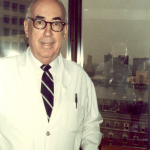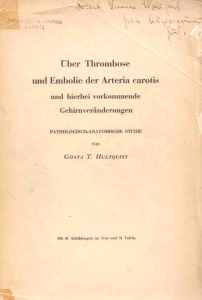Dawn of a new era: Gösta Hultquist’s thesis of carotid artery disease 1942
by Bo Norrving
A patient with a carotid TIA – emergency diagnosis and neuroimaging – urgent start of medical therapy – carotid ultrasound showing a severe carotid stenosis – carotid surgery: today this chain of care is well embedded in everyday clinical routine. However, only one generation ago none of the elements was known: the clinical features and urgency were not well recognized, diagnostic tools were unavailable, and medical and surgical therapies did not exist.
C. Miller Fisher (who died on 14 April earlier this year at the age of 98) is rightfully credited as the father of modern stroke neurology. His publication in 1951 delineated carotid occlusive disease and included the concept of TIA (a term that he actually coined), possible aethiologies, clinical implications and thoughts on therapeutic possibilities. This was C. Miller Fisher’s 1st seminal publication, which along with his extensive subsequent list of discoveries and writings constitute a core part of modern stroke history.
Less well known is the contribution on carotid occlusive disease by Gösta Hultquist in 1942 with his dissertation ”Über Thrombose und Embolie der Arteria carotis und hierbei vorkommende Gehirnveränderungen. Pathologisch-Anatomische Studie”. The work was carried out between 1938 and 1942 at the Department of Pathology at St. Göran’s Hospital in Stockholm, under the supervision of Folke Henschen.
Hultquist studied the carotid arteries in 1400 autopsies and found a rate of carotid disease of 3%. He described the clinical presentations in brief, the arterial lesions in extra- and intracranial large arteries, and the brain parenchymal lesions of 88 cases, and discussed symptoms corresponding to TIA, progressive stroke, collateral circulation, and carotid stenosis as well as occlusion. He illustrated the text with schematic drawings of the cerebral circulation and with 60 phothographs of arterial and brain lesions.

Hultquist’s work substantially extended knowledge and concepts on carotid disease. Why was he not more recognized? The occurence of the publication (in German) in 1942, at a critical period of the 2nd world war, likely contributed. Moreover, Hultquist did not himself develop his ideas in further publications and presentations – the thesis apparently marked the end of his scientific career. Even within Sweden, Hultquist’s findings were not further pursued by clinicians during the subsequent few years.
During an office cleaning at the department of neurology in Lund some years ago, Gösta Hultquist’s thesis re-appeared. The dedication indicated that this specific copy had belonged to Gunnar Wohlfart, the 1st chair of Neurology in Lund (see previous article by Sten Fredrikson in this series).
Gunnar Wohlfart was the opponent at Hultquist’s dissertation in 1942, and the copy is filled with Wohlfart’s remarks and comments. On the inside back cover is glued a type-written piece of paper with his concluding speech in verbatim at the dissertation. Wohlfart praised to the work and indicated the novelty of the findings, but remarked: ”…as a neurologist I must regret that this massive, and from a pathological perspective meticulously examined material, is not equally matched by clinical examinations and details, limiting the possibilities of clinico-pathological correlations”.
Wohlfart continued: ”…it has been very rewarding to read in detail this very extensive thesis…”, wrote a reminder to himself to then make a deep bow, and at the very end (in pencil writing) inserted a personal ”Puh!” with an exclamation mark (the thesis amounted to no less than 400 pages and obviously made tough reading).
In the history of stroke, Gösta Hultqvist (1910-1993) should certainly be recognized as one of the early pioneers that firmly recognized carotid disease as a cause of TIA and ischemic stroke. The 2012 EFNS congress in Stockholm will mark the 70th anniversary of Hultquist’s contribution.
1 C Miller Fisher. Photo by the author, Boston, July 3, 1985
2 Folke Henschen (right) at the Department of Pathology, Stockholm, 1944. Mural paiting by P Weiss. G Hultguist appears at the left (arrow) by the microscope.
3-4. Illustrations on carotid disease (photo and drawing) from the thesis.
5-6 Cover and inside page of Gösta Hultquist’s thesis 1942. with dedication to Gunnar Wohlfart.
7 John Walton (left) and Gunnar Wohlfart (right) at the World Neurology Congress in London 1955. Archives of the author.
Bo Norrving is Professor of Neurology at Lund University, Sweden. He will present his lecture “Dawn of a new era: Gösta Hultquist’s thesis of carotid artery disease 1942.” during the Special Session on Chapters in the history of Swedish Neuroscience during the EFNS Congress in Stockholm, Sweden.









